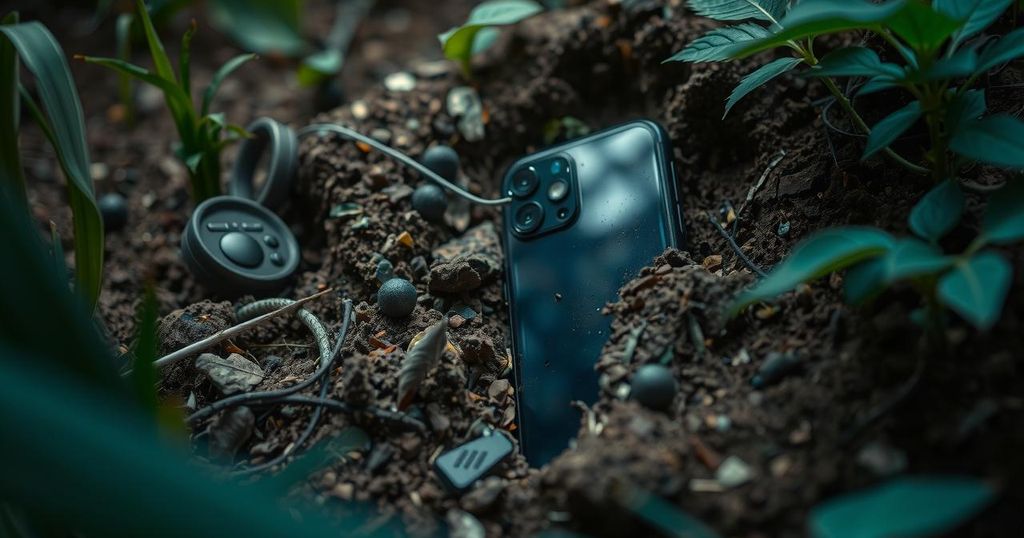The Democratic Republic of Congo’s ongoing conflict, driven by the M23 rebel group’s control over coltan mines, highlights the ethical challenges associated with tantalum sourced for mobile phones. The group exploits local miners through taxation and monopolistic practices, generating substantial revenue used to fund their military endeavors. Despite initiatives aimed at ensuring conflict-free sourcing, issues of corruption and inadequate monitoring allow mineral supply chains to incorporate conflict resources, raising urgent questions about accountability in global tech supply chains.
Mobile phones often contain tantalum, a rare metal sourced from the eastern Democratic Republic of Congo (DRC), where conflict remains prevalent. The M23 rebel group has recently garnered attention for its territorial advances in this mineral-rich region, strategically impacting the coltan mining industry. Tantalum is crucial for smartphones, enabling them to function efficiently while comprising only a negligible amount, lighter than half a garden pea.
Currently, the M23 controls key coltan-producing areas, including Rubaya, having established a monopoly and levied taxes on miners and traders. This organization began as a protector of an ethnic group but has evolved into a significant armed group reliant on mineral wealth for funding fighters and weaponry. Their actions contribute to a troubling cycle of violence and exploitation in DRC.
The mining operations largely rely on informal networks, with thousands working under perilous conditions. The M23’s grip on Rubaya has enabled it to impose fees, demanding permits and taxing coltan exports, which reportedly generates approximately $800,000 monthly for the rebel group. This revenue primarily sustains their military campaigns, raising concerns regarding global supply chains for conflict minerals like tantalum.
Efforts such as the Innovative Tin Supply Chain Initiative (Itsci) are designed to exclude conflict minerals from commerce; however, issues of enforcement and corruption plague the scheme. Monitoring challenges due to dispersed mining locations mean many miners operate without proper certification, allowing conflict ores to be mixed with legitimate supplies. Itsci has defended its methods amidst criticisms, claiming a positive impact despite its limited effectiveness in Rubaya.
The transportation of coltan often involves routes leading to Rwanda, where unregulated ores can corrupt supply chains. The M23’s earlier activity in the region saw Rwanda profiting from DRC’s instability, with an increase in coltan exports traced back to the conflict. As DRC grapples with ongoing warfare, accusations of exploitation persist, prompting international scrutiny of the corporate involvement in the region’s resources.
In response to the ongoing conflict, the Congolese government has filed complaints against multinational tech companies, such as Apple, for utilizing conflict minerals. Although Apple has denied wrongdoing and ceased sourcing tantalum from the affected regions, other companies may still engage with these resources as the M23 expands its control. The complexities surrounding mineral extraction in DRC necessitate greater transparency and ethical sourcing movements within the technology sector.
The ongoing conflict in the Democratic Republic of Congo has significant implications for the global supply of tantalum, a vital component in mobile phones and consumer electronics. The region is rich in coltan, the ore from which tantalum is extracted, and control of these resources is often linked to armed groups like M23. Since the group began its offensive in eastern DRC, it has exploited local mining operations to fund its militancy, creating a cycle of violence that raises ethical concerns for consumers worldwide. Large-scale mining operations are absent; instead, the extraction is conducted via small-scale, informal mining practices where laborers work in hazardous conditions. These operations put money into the hands of rebel factions and create significant challenges for efforts attempting to track the origins of such minerals. Such dynamics underscore the intersection of technology, global trade, and human rights within the context of a conflict-ridden region. Reform initiatives aimed at ensuring responsible sourcing and certification of conflict minerals have emerged, yet they face considerable obstacles. Issues of corruption, ineffective monitoring, and the evolving landscape of militant control challenge the integrity of these initiatives. As the demand for coltan continues with the rising use of smartphones, the international community must grapple with how to navigate the moral complexities posed by these supply chains.
The conflict in the Democratic Republic of Congo highlights the intricate relationship between global technology consumption and local resource exploitation. As the M23 rebel group further entrenches its control over key mining areas, the ethical sourcing of tantalum becomes increasingly fraught. Although initiatives like Itsci aim to purify the supply chain, corruption, and inefficiencies present significant barriers. Without clearer accountability and responsible sourcing practices, the consequences of consumer demand will continue to perpetuate violence and instability in the region.
Original Source: www.bbc.com




